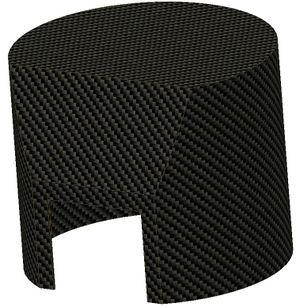Difference between revisions of "RC08Shell"
Jump to navigation
Jump to search
m (→Shell design) |
m (→Shell design) |
||
| Line 55: | Line 55: | ||
: The total height of the shell is 5.8 inches. The outer diameter is 7.04 inches with a shell thickness of 1/16 inch. The angle on top allows the vision system to better see the ball in front of the robot compared to last year. The angle starts 3 inches from the bottom of the shell at an angle 15.5 degrees from the vertical. This allows significant room for electrical components while maintaining room on top for the dots to locate the robot. The flat in the front is 3.664 inches wide. The cutout in front allows room for the dribbler and kicking system. It is 2.8 inches wide and 2.5 inches tall. | : The total height of the shell is 5.8 inches. The outer diameter is 7.04 inches with a shell thickness of 1/16 inch. The angle on top allows the vision system to better see the ball in front of the robot compared to last year. The angle starts 3 inches from the bottom of the shell at an angle 15.5 degrees from the vertical. This allows significant room for electrical components while maintaining room on top for the dots to locate the robot. The flat in the front is 3.664 inches wide. The cutout in front allows room for the dribbler and kicking system. It is 2.8 inches wide and 2.5 inches tall. | ||
===Manufacturing=== | ===Manufacturing=== | ||
| + | ====Mold==== | ||
| + | : The shell is being manufactures using a layup of kevlar and epoxy inside vacuum bags. A negative mold for the shell is made using particle board cut out on the CNC mill. Particle board was chosen since it is cheap and has fairly consistent isotropic properties in comparison to standard wood. The dimensions on it also tend to be more accurate. Cross sections of the shell are cut out of particle board starting from the bottom and moving to the top. Once all of the cross sections are cut, they are glued together to form a complete mold. | ||
| + | ====Layup==== | ||
Revision as of 16:35, 1 April 2008
Making up the Robocup 2008 Mechanical System, the shell protects the insides from a fast moving ball and should look cool.
Contents
Carbon Fiber Info
- Carbon Fiber Tutorial / Info (350z tech)
- Material Info / Handling / Tools (Society of Robots)
- How to PDF with pics
Parts & Components
Kevlar Fiber Roll
- Vendor - US composites
- Part No. - FG-KEV538
- Cost - $16.50 per yard
- Description - 0.01" thick 38" wide. Probably using 2 layers for the shell.
Wood for mold
- Vendor -
- Part No. -
- Cost -
- Description - 3/4" particle board. Used left over pieces from making cabinets.
Resin and Hardener
- Vendor - US composites
- Part No. - EPOX-635315
- Cost - $104
- Description - Epoxy and hardener with medium setting time. 2 gallons of epoxy and 85 fl oz. hardener.
Vacuum bag
- Vendor - US composites
- Part No. - VB-VF0272
- Cost - $3
- Description - Nylon bagging to hold vacuum. 72" wide, price is per yard.
Vacuum tape
- Vendor - US composites
- Part No. - VB-BT25
- Cost - $6
- Description - 25' length
Black pigment
- Vendor - US composites
- Part No. - AC-BL016
- Cost - $10.50
- Description - 1 pint
Bleeder cloth
- Vendor - US composites
- Part No. - VB-BLE60
- Cost - $4
- Description - Allows air flow and absorbs excess epoxy. 60" wide, price is per yard.
Shell design
Dimensions
- The total height of the shell is 5.8 inches. The outer diameter is 7.04 inches with a shell thickness of 1/16 inch. The angle on top allows the vision system to better see the ball in front of the robot compared to last year. The angle starts 3 inches from the bottom of the shell at an angle 15.5 degrees from the vertical. This allows significant room for electrical components while maintaining room on top for the dots to locate the robot. The flat in the front is 3.664 inches wide. The cutout in front allows room for the dribbler and kicking system. It is 2.8 inches wide and 2.5 inches tall.
Manufacturing
Mold
- The shell is being manufactures using a layup of kevlar and epoxy inside vacuum bags. A negative mold for the shell is made using particle board cut out on the CNC mill. Particle board was chosen since it is cheap and has fairly consistent isotropic properties in comparison to standard wood. The dimensions on it also tend to be more accurate. Cross sections of the shell are cut out of particle board starting from the bottom and moving to the top. Once all of the cross sections are cut, they are glued together to form a complete mold.
